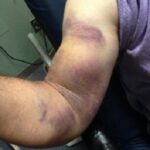Case Study:
Ruptured Long Head of Biceps
Presented by: Dr Jerome Goldberg
60 Year old male complains of pain, especially at night, as well as some loss of movement:
He lifted a heavy object with his dominant arm and noted deformity in upper arm followed by bruising.
- Upper arm deformity
- Bruising
- Tender shoulder & rotator cuff
- Limited range of motion
- Some restriction in power

Investigations:
- Xray to exclude bone damage/fracture
- MRI/MR Arthrogram if needed to determine if there is Rotator Cuff damage
- Ultrasounds are very inaccurate with respect to diagnosing rotator cuff tears
Treatment:
- An older patient with an isolated rupture of the long head of biceps (ie: no associated rotator cuff tear) will have no functional disability and symptoms generally settle within a week without treatment.
- The patient will be left with a cosmetic deformity only.
Comments:
About 50% of older patients who rupture the long head of biceps will have a torn rotator cuff.
If the patient has signs of a rotator cuff tear, that is significant pain, accompanied by loss of movement and particularly loss of power, then further investigation is required as indicated above, to determine the extent of the rotator cuff pathology. If the tear is large, and the patient is active, then surgery may need to be considered to repair the rotator cuff. If there is a small tear in a non-active patient then nonoperative measures may be appropriate.
It is certainly appropriate to refer such patients for an orthopaedic opinion to determine whether operative for nonoperative treatment is indicated.


